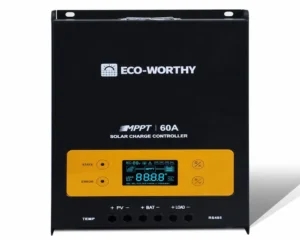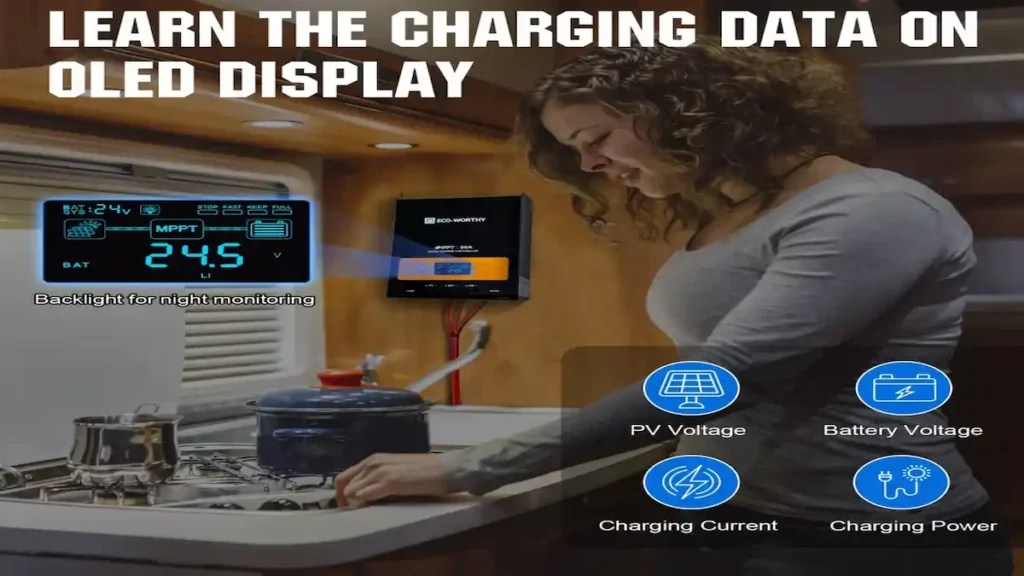If you are learning about solar power, you have surely heard the term solar charge controller mentioned several times. It is not the kind of word that rolls off the tongue easily, I know, but don’t worry — this little device plays a very key part in your solar system working correctly, especially if you are working with solar power battery charger.
Think of your solar charge controller as the traffic cop of your solar array. It controls the flow of power from your solar panels into your batteries, preventing any damage from occurring and your system giving you as much power as possible.
Last updated by John Tanko — September 7, 2025.
In Top Solar Picks, we will explore precisely what is a solar charge controller and why you will require it, and how to select the best to use in your home or off-grid application. If you are new to solar or want to upgrade, this is your guide.
What Does a Solar Charge Controller Do?
Essentially, the solar charge controller controls the voltage and current from your solar panels to your batteries. Why is that required? Batteries can be very easily overcharged and drained, which can severely shorten their life or even destroy them.
A controller prevents your solar power battery charger from overcharging your batteries in case of excessive sunlight to make them get too hot or be ruined. When the sun is not in sight at night, electricity will sometimes flow in the opposite direction from your batteries to your panels and waste precious energy. The controller prevents this from occurring by behaving like an intelligent gatekeeper and protecting your investment.
In summary, it maintains your batteries in a healthy state, saves you money on replacements, and maintains your solar system in top operating condition.
Why Should I Use the Correct Solar Charge Controller?
There are several different solar charge controllers on the market and the right one depends on your specific requirements.
- If you’re installing a small solar array and solar battery charger, you can perhaps use a basic PWM (Pulse Width Modulation) controller. It is cheap and reliable and is well suited to simple systems like RVs, boats, or small off-grid cabins.
- For bigger or more complicated setups, it’s well worth spending more on an MPPT (Maximum Power Point Tracking) controller. It squeezes out as much power as possible from your panels, increasing efficiency by as much as 30%. That results in faster charging and more battery life, especially with the use of more voltage solar panels.
Be familiar with the difference between such varieties in order not to waste money on either too simple or too expensive of a controller to meet your needs.
Types of Solar Charge Controllers: Which One Is Right for Your Needs?
When it comes to choosing a solar charge controller, understanding the different types available can make a big difference in performance and cost. There are two main types of solar charge controllers you’ll encounter:
1. PWM (Pulse Width Modulation) Controllers

PWM controllers are the most common and affordable type of solar charge controller. They work by gradually reducing the amount of power sent to your battery as it approaches full charge, helping prevent overcharging.
Best For: Small to medium-sized solar systems with panels that match the battery voltage.
Advantages: Simple, reliable, and budget-friendly.
Limitations: Less efficient with larger or higher voltage solar panels; can waste some energy compared to advanced controllers.
If you have a basic setup with a solar power battery charger or a small off-grid system, a PWM controller might be all you need.
2. MPPT (Maximum Power Point Tracking) Controllers

MPPT controllers represent the latest technology in solar charge regulation. They constantly track the maximum power point of your solar panels, optimizing the voltage and current to extract the most energy possible.
Best For: Larger systems, higher voltage panels, and setups where maximizing efficiency is critical.
Advantages: Can improve energy harvest by up to 30%, especially on cloudy days or in colder climates.
Limitations: Higher upfront cost but better long-term savings.
Because of their efficiency, MPPT controllers work perfectly with high-capacity solar power battery chargers and more complex battery banks.
Not sure which solar charge controller is right for your setup? Check out our detailed guide on MPPT vs PWM: Selecting the Right Solar Charge Controller for Optimal Performance.
In this article, we compare efficiency, cost, battery compatibility, and long-term savings so you can choose the best controller for your solar system.
Which Type Should You Choose?
For budget-conscious beginners or small systems, PWM controllers are a great starting point.
For those who want to maximize solar energy, save money long-term, and run bigger setups, MPPT controllers are the better investment.
Knowing the difference helps you pick the right solar charge controller to protect your batteries and make your solar power battery charger more effective.
Looking for more solar and battery reviews? Explore these guides:
EcoFlow Battery Review 2025: Fast Charging, Backup Power & DELTA Pro Ultra Tested
Anker Power Station Review: Are They Worth It for Home Backup or Camping?
Best Solar Cables and Solar Panel Extension Cables for Your System (2025 Buying Guide)
Best 5000-Watt Inverter for Home, RV, and Solar (2025): Top Power Inverters Reviewed
Eco Worthy Battery Review: A Deep Dive Into 51.2V Server Rack Features
Top 12 Volt Battery Pack – 280Ah LiFePO4 for Camping & Home Use
Why Eco-Worthy’s Solar Charge Controller Is One of the Best in Advanced Solar Tech
When it comes to cutting-edge solar charge controllers, Eco-Worthy stands out as a leader in innovation and reliability. Their controllers combine advanced technology with user-friendly features, making them an excellent choice for anyone serious about optimizing their solar power system.
Here’s why the Eco-Worthy solar charge controller is considered one of the best:
Wide Range of Input & Output Compatibility
Whether your system runs on 12V, 24V, 36V, or up to 48V DC, Eco-Worthy’s controllers can handle it. They support solar arrays up to 780W at 12V and an impressive 3120W at 48V, with a maximum output current of 60A. This flexibility means you can confidently scale your solar power setup without worrying about compatibility.99% Efficient MPPT Technology
Thanks to state-of-the-art Maximum Power Point Tracking (MPPT) technology, Eco-Worthy controllers achieve a tracking efficiency of up to 99% and a peak conversion efficiency of 98%. This means even on cloudy or partly sunny days, the controller extracts nearly every bit of usable power from your solar panels, ensuring minimal energy waste.Compatible with All Battery Types
Whether you’re using Gel, AGM, Lithium, LiFePO4, Flooded, or even NCM/NCA batteries, Eco-Worthy’s controllers have you covered. They can charge and discharge battery banks at 12, 24, 36, or 48 volts, adapting seamlessly to your specific battery chemistry and system setup.OLED Screen for Real-Time Monitoring

The built-in OLED display provides clear, at-a-glance information on PV voltage, battery voltage, charging current, and charging power. Plus, intuitive buttons allow you to switch battery types easily, giving you full control and peace of mind.
Advanced Safety Features
Safety is a top priority with Eco-Worthy’s controllers. They include multiple electronic protections to guard against Reverse Polarity, Short Circuits, High Temperature, Over-Current, and Over-Voltage or Low-Voltage conditions. These safeguards protect your system from damage and prevent dangerous situations like explosions or fires.
In summary, Eco-Worthy’s solar charge controllers offer a perfect blend of advanced technology, wide compatibility, and robust safety features. If you want a dependable, high-efficiency controller to maximize the performance of your solar power battery charger and extend your system’s life, Eco-Worthy is an outstanding choice.
How to choose the best solar charge controller to suit your requirements
Here are some key points to keep in mind while choosing a controller:
- Match the Voltage: Make certain your controller’s voltage is identical to your system (12V, 24V, or 48V).
- Check the Amperage: The controller needs to manage how much current your solar panels generate.
- Consider Your Battery Type: Different batteries (lead-acid, lithium-ion, AGM) require different charging profiles.
- Compatibility with Your Solar Power Battery Charger: If you use a separate charger, your controller will need to be compatible with it.
Frequent Questions about Solar Charge Controllers
Can I skip installing a solar charge controller?
Technically, you can get by on very small systems without one, but you are taking a risk. Without a charge controller, your battery can be overcharged or drained easily, which will shorten your battery’s life considerably. A solar charge controller will safeguard your battery and your solar power battery charger, and it is well worth the expense.
how long solar charge controllers last?
Good controllers can last between 5 to 15 years provided they are well maintained. Avoid exposing them to harsh weather conditions in the open without covers, and check them periodically such that you can detect any fault early enough.
Will Using an MPPT Controller Save Me Money?
Yes! Although more costly to buy, MPPT controllers get your system to produce more and you get more out of the solar panels and more life from your battery. This is especially true if your solar system is large and you use your solar power battery charger extensively.
Closing Thought
Protect Your Investment with the Appropriate Controller Your solar charge controller might seem like it occupies a minor role in your solar array, yet it is one of the most important. It protects your batteries, maximises your systems efficiency, and provides you with the optimal output from your solar power battery charger. The right kind — either MPPT or PWM — to opt for is a matter of your aspirations, system size, and budget. Spend some time understanding your needs, and you will end up saving money and hassle down the line.
Author
Oscar Marc writes about solar energy with one goal in mind: making clean power easier to understand and access for everyone. At Top Solar Picks, he covers everything from solar panel reviews to tips f...